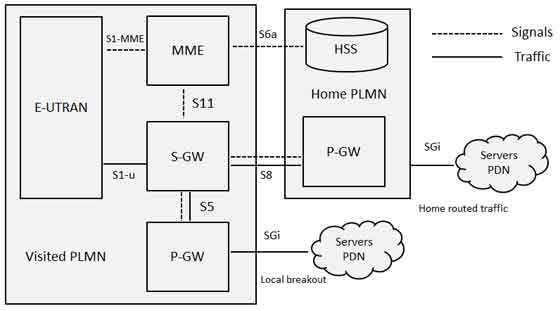
- LTE Tutorial
- LTE - Home
- LTE - Overview
- LTE - Basic Parameters
- LTE - Network Architecture
- LTE - Roaming Architecture
- LTE - Numbering & Addressing
- LTE - Radio Protocol Architecture
- LTE - Protocol Stack Layers
- LTE - Layers Data Flow
- LTE - Communication Channels
- LTE - OFDM Technology
- LTE - Glossary
- LTE Useful Resources
- LTE - Quick Guide
- LTE - Useful Resources
- LTE - Discussion
LTE Roaming Architecture
A network run by one operator in one country is known as a Public Land Mobile Network (PLMN) and when a subscribed user uses his operator's PLMN then it is said Home-PLMN but roaming allows users to move outside their home network and using the resources from other operator's network. This other network is called Visited-PLMN.
A roaming user is connected to the E-UTRAN, MME and S-GW of the visited LTE network. However, LTE/SAE allows the P-GW of either the visited or the home network to be used, as shown in below:

The home network's P-GW allows the user to access the home operator's services even while in a visited network. A P-GW in the visited network allows a "local breakout" to the Internet in the visited network.
The interface between the serving and PDN gateways is known as S5/S8. This has two slightly different implementations, namely S5 if the two devices are in the same network, and S8 if they are in different networks. For mobiles that are not roaming, the serving and PDN gateways can be integrated into a single device, so that the S5/S8 interface vanishes altogether.
LTE Roaming Charging
The complexities of the new charging mechanisms required to support 4G roaming are much more abundant than in a 3G environment. Few words about both pre-paid and post-paid charging for LTE roaming is given below:
Prepaid Charging - The CAMEL standard, which enables prepaid services in 3G, is not supported in LTE; therefore, prepaid customer information must be routed back to the home network as opposed to being handled by the local visited network. As a result, operators must rely on new accounting flows to access prepaid customer data, such as through their P-Gateways in both IMS and non-IMS environments or via their CSCF in an IMS environment.
Postpaid Charging - Postpaid data-usage charging works the same in LTE as it does in 3G, using versions TAP 3.11 or 3.12. With local breakout of IMS services, TAP 3.12 is required.
Operators do not have the same amount of visibility into subscriber activities as they do in home-routing scenarios in case of local breakout scenarios because subscriber-data sessions are kept within the visited network; therefore, in order for the home operator to capture real-time information on both pre- and postpaid customers, it must establish a Diameter interface between charging systems and the visited network's P-Gateway.
In case of local breakout of ims services scenario, the visited network creates call detail records (CDRs) from the S-Gateway(s), however, these CDRs do not contain all of the information required to create a TAP 3.12 mobile session or messaging event record for the service usage. As a result, operators must correlate the core data network CDRs with the IMS CDRs to create TAP records.
To Continue Learning Please Login